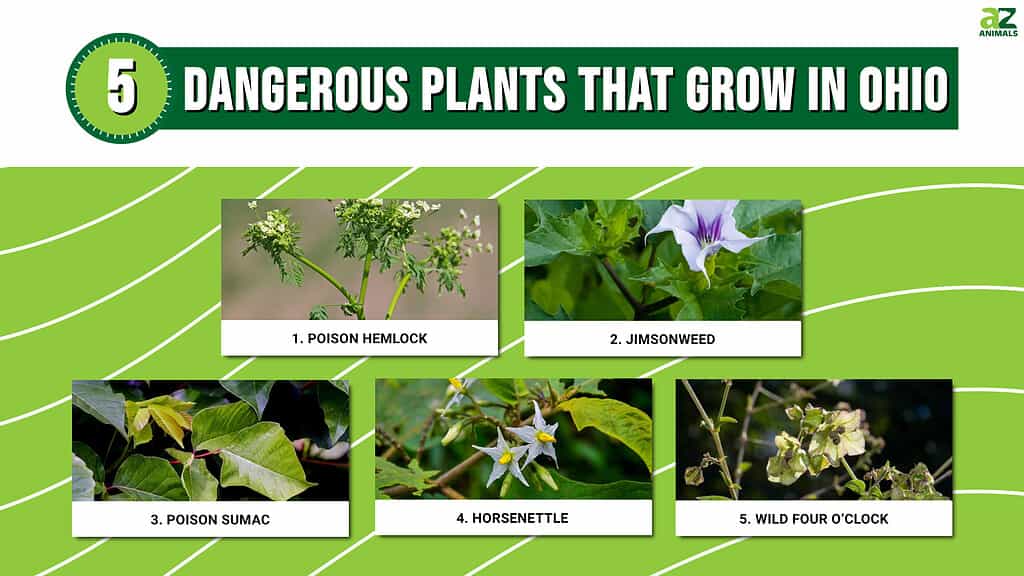
There are hundreds of poisonous plants in the United States. Their toxicity is due to many things, including amino acids, proteins, alkaloids, and glycosides. And while many toxic plants cause mild symptoms and irritations when touched or ingested, others can cause severe symptoms and rapid death. Ohio has several life-threatening poisonous plants that should be avoided and eradicated. Discover five dangerous plants that grow in Ohio, including when they grow, where they grow, and how lethal they are.
1. Poison Hemlock (Conium maculatum)
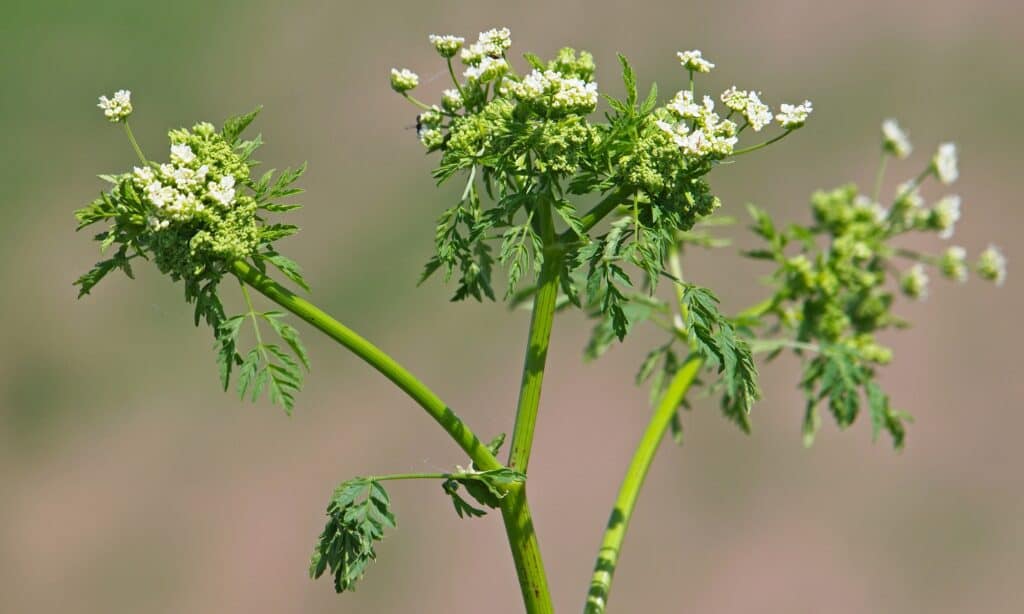
Poison hemlock can be found along roadsides, field edges, creek beds, and irrigation ditches.
©iStock.com/emilio100
Names: Deadly hemlock, poison parsley, European hemlock, spotted hemlock, California fern
When it Grows: Poison hemlock is a highly toxic biennial plant and noxious weed in the carrot family. These plants begin growing in the early spring and feature erect clusters of white flowers. The flowers transform into green, oval-shaped fruits.
Location: Poison hemlock is spreading across the United States and can be found in every contiguous state. You can find this deadly plant along roadsides, the edges of fields, irrigation ditches, and near creek beds.
How it is Dangerous: All parts of the plant are deadly if ingested, including roots, stems, leaves, and seeds. The toxic alkaloids can be fatal to humans, pets, and livestock. It can cause symptoms within 30 minutes, such as sweating, vomiting, salivation, rapid heartbeat, confusion, respiratory failure, acute renal failure, and death.
2. Jimsonweed (Datura stramonium)
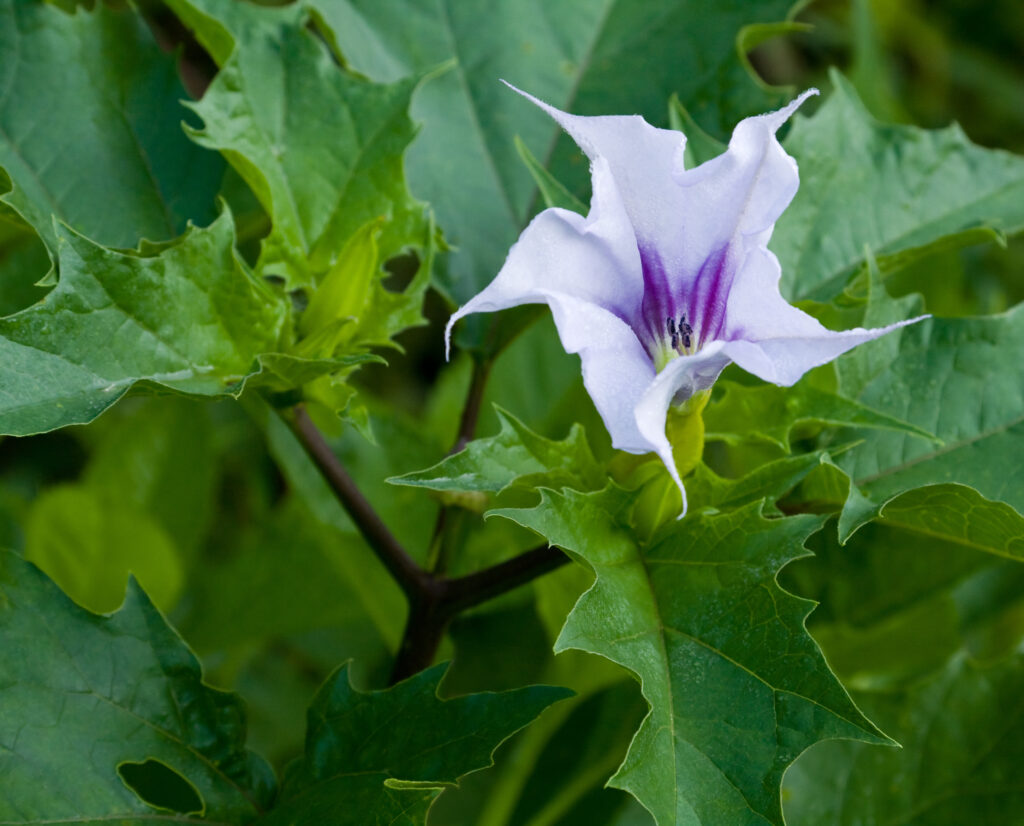
Although death is uncommon, devil’s weed intoxication produces bizarre behaviors, insomnia, nausea, hallucinations, and amnesia.
©Melinda Fawver/Shutterstock.com
Names: Jamestown weed, thornapple, stinkweed, Devil’s snare
When it Grows: Jimson weed is a smelly weed from the Nightshade family. It is an annual herbaceous plant that grows in the summer. It can grow up to 5 feet tall and feature thick, dark purple stems and white and purple flowers. The alkaloids that cause its toxicity are found in all parts of the plant.
Location: These poisonous plants like rich soil and cultivated fields. You can also spot them in waste lots and grazing pastures. However, most animals stay away from this weed due to its foil taste and smell.
How it is Dangerous: If ingested, humans will need immediate medical attention. Jimsonweed can cause symptoms such as rapid pulse, difficulty breathing, muscle twitching, diarrhea, convulsions, coma, and death.
3. Poison Sumac (Toxicodendron vernix)
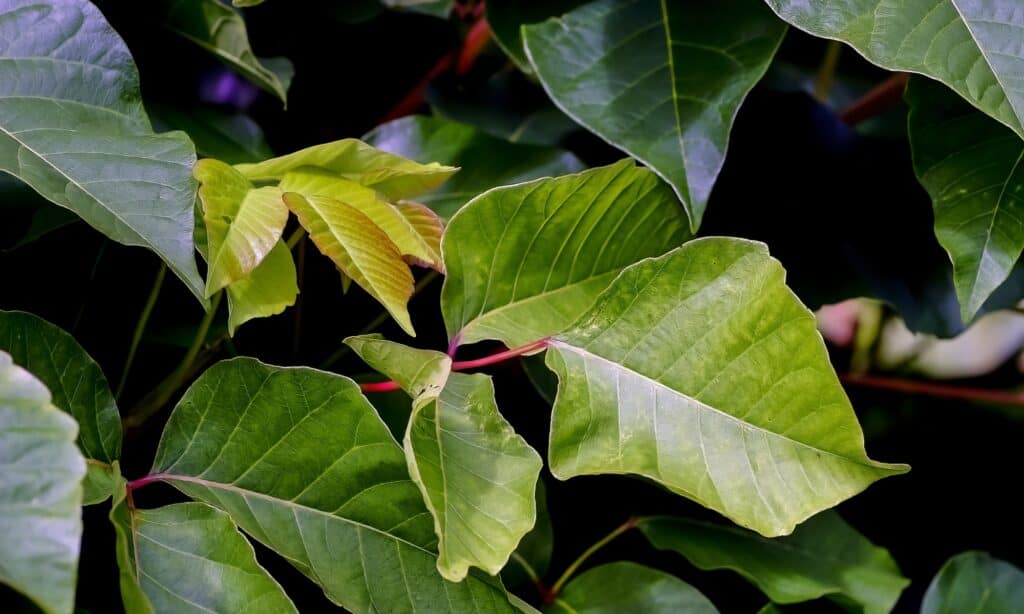
Poison sumac grows in Ohio’s wetlands, such as swamps and marshes.
©iStock.com/Werner Meidinger
Names: Swamp Sumach, poison elder, thunderwood
When it Grows: Poison sumac is a small tree or shrub that grows in wet areas. They possess smooth, green leaves, loose strands of round berries, and deep red stems. Its fruit typically ripens in late summer. And its leaves turn red and orange during the fall. In winter, the trees are bare.
Location: These plants grow in Ohio’s wetlands, such as marshes, wooded swamps, and the edges of lakes and ponds. These plants can be somewhat rare, especially compared to poison ivy.
How it is Dangerous: Poison sumac contains allergenic oil that causes skin reactions, such as an itchy rash and painful blisters. This poisonous Ohio plant is not life-threatening.
4. Horsenettle (Solanum carolinense)
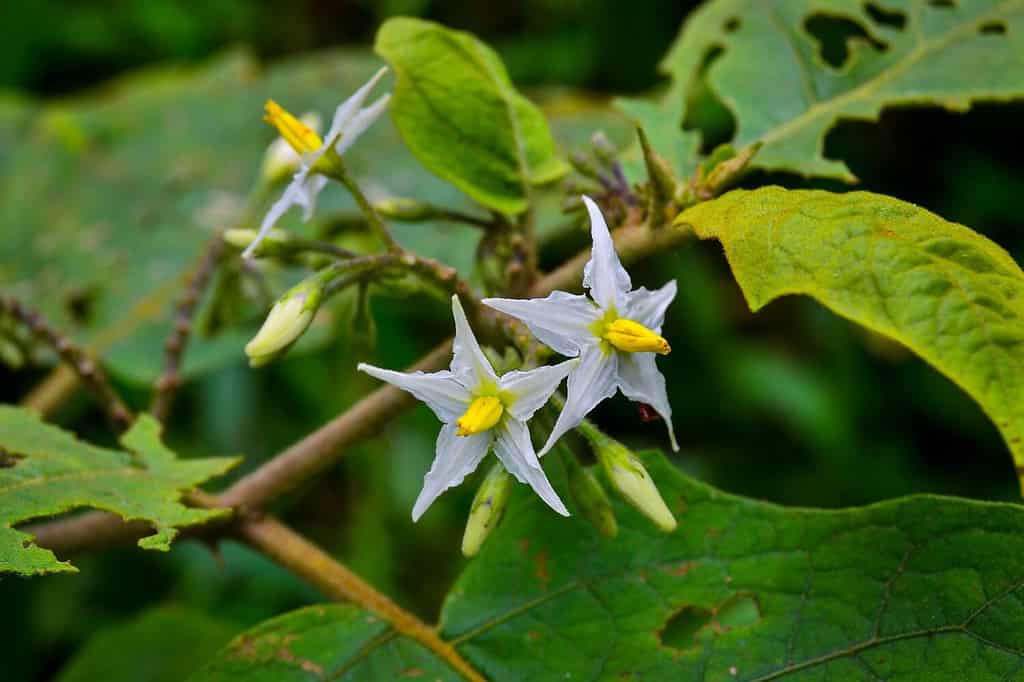
Horsenettle is most toxic during the fall. It can cause stomach irritation and severe symptoms, like weakness and difficulty breathing.
©AsepSur/Shutterstock.com
Names: Radical weed, sand brier, bull nettle, the apple of Sodom, Devil’s tomato, wild tomato
When it Grows: Horsenettle is a perennial with thorny stems and leaves. It produces elongated clusters of white and purple flowers, which bloom from May to October. The fruit looks like a tiny tomato and becomes yellow when ripe. The fruit lasts through the winter.
Location: These dangerous plants that grow in Ohio are native grassland flowers that prefer disturbed environments, such as prairies, fields, and wood clearings. They can also grow in gardens.
How it is Dangerous: All parts of the horsenettle plant are toxic, especially during the fall. Those who ingest large quantities (do not eat these plants at all) can experience excessive salivation, diarrhea, constipation, weakness, difficulty breathing, collapse, and death.
5. Wild Four O’Clock (Mirabilis nyctaginea)

Wild four o’clock grows along roadsides, trail edges, fields, and even in sidewalk cracks.
©Ksenia Lada/Shutterstock.com
Names: Heart leaf four o’clock, heart-leaf umbrella-wort
When it Grows: The wild four o’clock is an herbaceous perennial that grows up to 4 feet tall. They possess light green stems, heart-shaped leaves, and flat clusters of magenta stalked flowers. These wildflowers bloom in summer through fall.
Location: They grow like weeds and can be found along roadsides, trail edges, fields, and sidewalk cracks.
How it is Dangerous: The sap can irritate the skin. And ingesting parts of the flower can cause intestinal issues, such as vomiting and diarrhea. They are also moderately toxic to dogs. While they are poisonous, they contain low toxicity and are not considered life-threatening.
Summary of 5 Dangerous Plants That Grow in Ohio
Here’s a recap of five plants dangerous to humans and animals that can be found in the state of Ohio:
| Number | Plant | Scientific Name | How It’s Dangerous |
|---|---|---|---|
| 1 | Poison Hemlock | Conium maculatum | All parts are deadly if ingested, including roots, stems, leaves, and seeds. The toxic alkaloids can be fatal to humans, pets, and livestock. |
| 2 | Jimsonweed | Datura stramonium | If ingested, humans will need immediate medical attention. |
| 3 | Poison Sumac | Toxicodendron vernix | This plant contains allergenic oil that causes skin reactions, such as an itchy rash and painful blisters. |
| 4 | Horsenettle | Solanum carolinense | All parts are toxic, especially during the fall. |
| 5 | Wild Four O’Clock | Mirabilis nyctaginea | The sap can irritate the skin. Ingesting parts of the flower can cause intestinal issues, such as vomiting and diarrhea. It is also moderately toxic to dogs. |
The photo featured at the top of this post is © iStock.com/gabrielabertolini
Thank you for reading! Have some feedback for us? Contact the AZ Animals editorial team.






